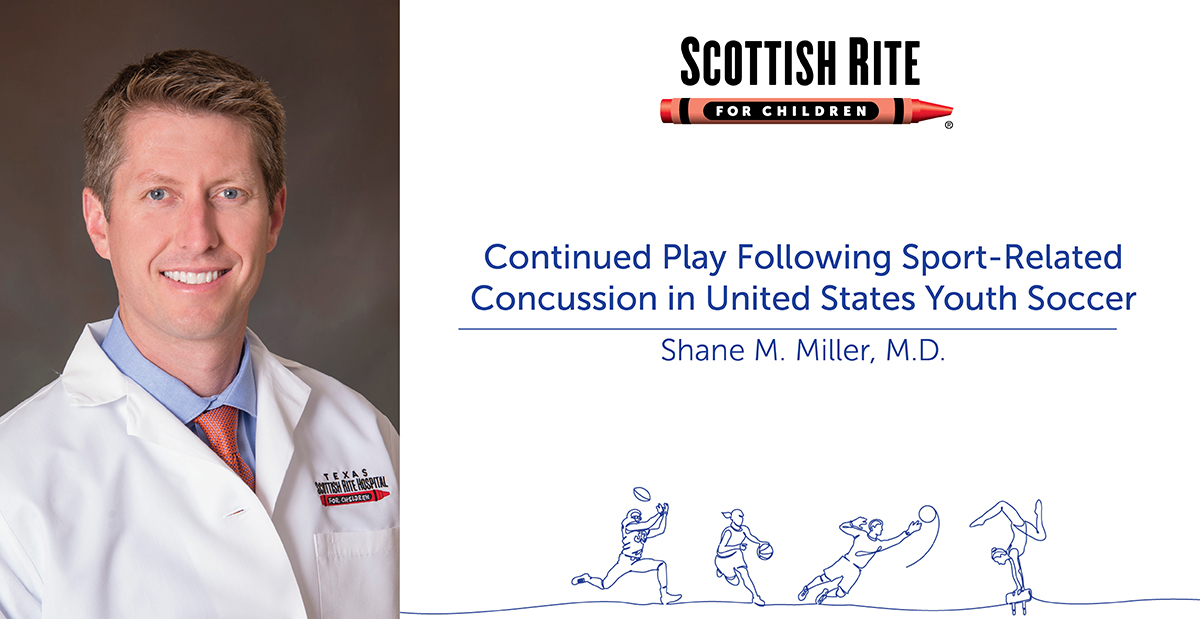
Aug 11, 2020 / Research & Innovation
Concussions and Continued Play in Young Athletes
Soccer is one of the most popular sports in the world and is quickly becoming a favorite among youth in the United States. While the exercise involved with soccer is beneficial, the sport also brings an increased risk of injuries, including concussions. Regulations have been established in each state to protect young athletes. In Texas, these regulations call for mandatory education of athletes and parents, immediate removal from play at the time of suspected concussion and return to play only with written clearance by a licensed physician.
However, the sports medicine team at Scottish Rite for Children saw signs that those regulations are not always followed in youth soccer, and conducted a study to determine the frequency at which young athletes continued to play after sustaining an injury.
Sports medicine physician Shane M. Miller, M.D., and the study team looked at records of 87 patients treated at our facility for a soccer-related concussion. They evaluated symptoms reported from the day of their injury, symptoms at the time of the visits and if the athletes had continued to play on the same day of their injury or not. The study revealed that approximately 40% of youth soccer players continued to play after sustaining a concussion.
When young athletes continue to play after an injury, they are at risk of suffering a more severe injury. One of the most surprising findings of this study was that over 50% of the girls who participated in the study continued to play the same day as their concussion compared to only 17% of boys. Many studies have demonstrated that girl soccer players have higher concussion rates than boys. This discrepancy may be due to the competitive culture in girls’ soccer that emphasizes toughness. Another factor may be that girls’ soccer teams do not have the same access to medical providers as the boys’ teams, which suggests that they are not adequately evaluated and removed from play after a suspected head injury.
The study showed a critical need for focused education in the soccer community on recognizing concussion symptoms, why signs of concussions must be reported, and why players should never return to play the same day of their injury. Sometimes players do not want to be pulled from practice or a game because they think they will let their coaches and teammates down. However, when young athletes, parents and coaches are all trained to recognize concussion symptoms and understand the serious risks involved with continued play after an injury, there is a team effort to keep players safe.
Learn more about sport-related concussion in young athletes.
This peer-reviewed study is published in the International Journal for Sports Medicine online in February 2020. Read the full article.
However, the sports medicine team at Scottish Rite for Children saw signs that those regulations are not always followed in youth soccer, and conducted a study to determine the frequency at which young athletes continued to play after sustaining an injury.
Sports medicine physician Shane M. Miller, M.D., and the study team looked at records of 87 patients treated at our facility for a soccer-related concussion. They evaluated symptoms reported from the day of their injury, symptoms at the time of the visits and if the athletes had continued to play on the same day of their injury or not. The study revealed that approximately 40% of youth soccer players continued to play after sustaining a concussion.
When young athletes continue to play after an injury, they are at risk of suffering a more severe injury. One of the most surprising findings of this study was that over 50% of the girls who participated in the study continued to play the same day as their concussion compared to only 17% of boys. Many studies have demonstrated that girl soccer players have higher concussion rates than boys. This discrepancy may be due to the competitive culture in girls’ soccer that emphasizes toughness. Another factor may be that girls’ soccer teams do not have the same access to medical providers as the boys’ teams, which suggests that they are not adequately evaluated and removed from play after a suspected head injury.
The study showed a critical need for focused education in the soccer community on recognizing concussion symptoms, why signs of concussions must be reported, and why players should never return to play the same day of their injury. Sometimes players do not want to be pulled from practice or a game because they think they will let their coaches and teammates down. However, when young athletes, parents and coaches are all trained to recognize concussion symptoms and understand the serious risks involved with continued play after an injury, there is a team effort to keep players safe.
Learn more about sport-related concussion in young athletes.
This peer-reviewed study is published in the International Journal for Sports Medicine online in February 2020. Read the full article.



